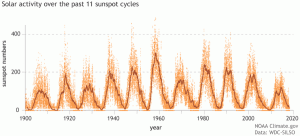TAG: GS 3: ECOLOGY AND ENVIRONMENT
THE CONTEXT: Climate change remains a pressing concern, with various factors contributing to the rising global temperatures. In this installment, we delve into a commonly asked question: “Is the Sun behind the rising global temperatures?” Let’s explore the intricate relationship between the Sun and Earth’s climate.
EXPLANATION:
- The Sun, a middle-aged star, serves as the primary source of energy for Earth’s biological and physical processes.
- Its radiant heat plays a pivotal role in maintaining liquid water, fostering plant growth, and influencing the planet’s weather systems.
- However, the Sun’s brightness is not constant, undergoing an 11-year cycle of high and low activity due to magnetic pole reversals.
 Solar activity
Solar activity
Solar Variability and Historical Changes
- NASA reports indicate that during each solar cycle, the Sun undergoes fluctuations in radiation levels, material ejected into space, sunspots, and solar flares.
- Historical data reveals a small increase in sunlight reaching Earth between the late 1800s and mid-1900s.
- It contributes to a minor fraction of the observed warming (0.1 degree Celsius) since the pre-industrial era.
Debunking the Sun as the Driving Force
- Despite historical variations in solar activity, the Sun is not the primary driver of current global warming.
- Over the past five decades, Earth’s average temperature has surged to unprecedented levels, but the Sun’s energy output has only fluctuated by a mere 0.1%, as confirmed by NASA’s 2019 report.
- This negligible change discounts the Sun as a major contributor to contemporary global warming.
Atmospheric Observations: Greenhouse Gases vs. Solar Influence
- Contrary to the hypothesis that increased solar energy output would warm all layers of Earth’s atmosphere, recent observations paint a different picture.
- While the lower atmosphere experiences warming, the upper atmosphere has displayed cooling trends.
- This disparity aligns more closely with the effects of greenhouse gases, challenging the notion of the Sun as the primary culprit.
Human Activities and Global Warming
- A pivotal revelation emerges when examining the timeline of global temperature increases since 1975.
- Earth has warmed at a consistent rate of approximately 0.15 to 0.20 degrees Celsius per decade.
- The correlation between this warming trend and the escalating levels of greenhouse gases strongly implicates human activities, particularly the burning of fossil fuels, deforestation, and industrial processes, as the driving forces behind the current phase of global warming.
Conclusion
- In summary, while the Sun’s variability has historically contributed to slight temperature fluctuations, it is not the driving force behind the recent surge in global temperatures.
- Human-induced factors, notably the emission of greenhouse gases, emerge as the primary culprits.
- Understanding these dynamics is crucial for implementing effective strategies to mitigate the impacts of climate change and work towards a sustainable future.

